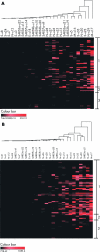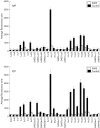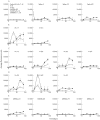Specific epitopes of the structural and hypothetical proteins elicit variable humoral responses in SARS patients
- PMID: 16461566
- PMCID: PMC1860290
- DOI: 10.1136/jcp.2005.029868
Specific epitopes of the structural and hypothetical proteins elicit variable humoral responses in SARS patients
Abstract
Background: Severe acute respiratory syndrome (SARS) is an infectious disease which was caused by a novel coronavirus (SARS-CoV). SARS has caused an outbreak in the world during 2003 and 2004, with 8098 individuals being infected and a death toll of 774 in 28 regions around the world. Specific humoral responses to viral infection remain unclear.
Objective: To analyse the antigenicity of the SARS-CoV genome and identify potential antigenic epitopes in the structural proteins.
Methods: Potential antigenic epitopes were identified in the structural proteins (nucleocapsid, membrane, spike, and small envelope proteins) and hypothetical proteins (SARS3a, 3b, 6, 7a, and 9b) that are specific for SARS-CoV. A peptide chip platform was created and the profiles of antibodies to these epitopes were investigated in 59 different SARS patients' sera obtained 6-103 days after the onset of the illness. Serial sera from five additional patients were also studied.
Results: Epitopes at the N-terminus of the membrane protein and the C-terminus of nucleocapsid protein elicited strong antibody responses. Epitopes on the spike protein were only moderately immunogenic but the effects were persistent. Antibodies were also detected for some putative proteins, noticeably the C-termini of SARS3a and SARS6.
Conclusions: Important epitopes of the SARS-CoV genome that may serve as potential markers for the viral infection are identified. These specific antigenic sites may also be important for vaccine development against this new fatal infectious disease.
References
-
- WHO Severe acute respiratory syndrome (SARS). http://www.who.int/csr/sars/en/; last updated 2 July 2004
Publication types
MeSH terms
Substances
LinkOut - more resources
Full Text Sources
Other Literature Sources
Miscellaneous







